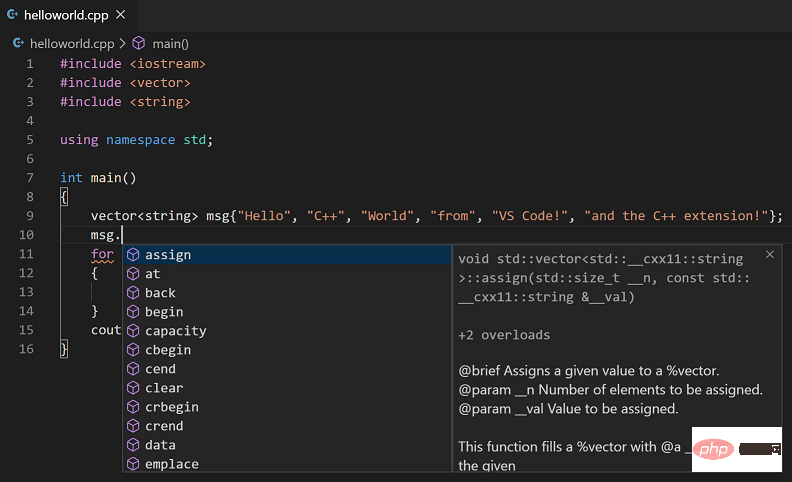 Backend Development
Backend Development C++
C++ Container size and allocation strategy trade-offs for C++ container libraries
Container size and allocation strategy trade-offs for C++ container librariesC++ STL Container size and allocation strategy trade-offs: Container size: Fixed size: Pre-allocates a fixed memory block, suitable for cases where the capacity is known. Dynamic size: Adjustable size at runtime, suitable for situations where capacity is uncertain. Allocation strategy: Continuous allocation: allocate all memory at once, suitable for scenarios that require continuous access to data. On-demand allocation: Allocate memory on demand, suitable for scenarios where sparse data is stored. Trade-offs: Memory usage: Fixed-size containers save more memory, while dynamic-size containers save more memory when data is sparse. Performance: Continuous allocation performs better when accessing continuous data, and on-demand allocation reduces memory allocation overhead

trade-offs between container size and allocation strategy of the C++ container library
When using the C++ Standard Template Library (STL), it is critical to understand the size and allocation strategy of the container. Choosing the right strategy can improve the efficiency and performance of your code.
Container size
The size of the container determines the number of elements it can hold. There are two main types of container sizes:
- Fixed size: Containers create a pre-allocated fixed-size block of memory.
- Dynamic sizing: A container can resize itself at runtime to accommodate more elements.
Practical example:
If you know that the container needs to hold a fixed number of elements, a fixed-size container is usually more efficient. For example, if you want to store a predefined set of values, you can use std::array. If the container needs to accommodate dynamic data, a dynamically sized container such as std::vector is more appropriate.
Allocation strategy
The allocation strategy determines how the container allocates memory. There are two main allocation strategies:
- Continuous allocation: The container allocates the memory required for all elements at once.
- Allocation on demand: The container only allocates memory when needed and gradually expands as elements are added.
Practical case:
Continuous allocation is useful for large containers or containers that require continuous access to data. It reduces fragmentation and improves performance. For example, if you know that the container will be filled all at once, you can use the std::vector and reserve() methods to preallocate contiguous memory. On-demand allocation is more useful for containers with sparse elements or containers that require minimal memory overhead. For example, if you are not sure how many elements a container requires, you can use std::list or std::forward_list.
Trade-offs
When choosing a container size and allocation strategy, you need to consider the following trade-offs:
- Memory usage: Fixed-size containers typically use more less memory, while dynamically sized containers use less memory when data is sparse.
- Performance: Continuous allocation can improve the performance when accessing continuous data, while on-demand allocation can reduce the overhead of memory allocation.
- Flexibility: Dynamically sized containers allow resizing at runtime, while fixed size containers are not flexible.
Conclusion
Understanding the container sizing and allocation strategies of the C++ container library is critical to optimizing the efficiency and performance of your code. By carefully considering these factors, you can choose the container that best suits your specific needs.
The above is the detailed content of Container size and allocation strategy trade-offs for C++ container libraries. For more information, please follow other related articles on the PHP Chinese website!
 Windows 11 系统下的五款最佳免费 C++ 编译器推荐Apr 23, 2023 am 08:52 AM
Windows 11 系统下的五款最佳免费 C++ 编译器推荐Apr 23, 2023 am 08:52 AMC++是一种广泛使用的面向对象的计算机编程语言,它支持您与之交互的大多数应用程序和网站。你需要编译器和集成开发环境来开发C++应用程序,既然你在这里,我猜你正在寻找一个。我们将在本文中介绍一些适用于Windows11的C++编译器的主要推荐。许多审查的编译器将主要用于C++,但也有许多通用编译器您可能想尝试。MinGW可以在Windows11上运行吗?在本文中,我们没有将MinGW作为独立编译器进行讨论,但如果讨论了某些IDE中的功能,并且是DevC++编译器的首选
 C++报错:变量未初始化,应该如何解决?Aug 21, 2023 pm 10:01 PM
C++报错:变量未初始化,应该如何解决?Aug 21, 2023 pm 10:01 PM在C++程序开发中,当我们声明了一个变量但是没有对其进行初始化,就会出现“变量未初始化”的报错。这种报错经常会让人感到很困惑和无从下手,因为这种错误并不像其他常见的语法错误那样具体,也不会给出特定的代码行数或者错误类型。因此,下面我们将详细介绍变量未初始化的问题,以及如何解决这个报错。一、什么是变量未初始化错误?变量未初始化是指在程序中声明了一个变量但是没有
 C++编译错误:未定义的引用,该怎么解决?Aug 21, 2023 pm 08:52 PM
C++编译错误:未定义的引用,该怎么解决?Aug 21, 2023 pm 08:52 PMC++是一门广受欢迎的编程语言,但是在使用过程中,经常会出现“未定义的引用”这个编译错误,给程序的开发带来了诸多麻烦。本篇文章将从出错原因和解决方法两个方面,探讨“未定义的引用”错误的解决方法。一、出错原因C++编译器在编译一个源文件时,会将它分为两个阶段:编译阶段和链接阶段。编译阶段将源文件中的源码转换为汇编代码,而链接阶段将不同的源文件合并为一个可执行文
 如何优化C++开发中的文件读写性能Aug 21, 2023 pm 10:13 PM
如何优化C++开发中的文件读写性能Aug 21, 2023 pm 10:13 PM如何优化C++开发中的文件读写性能在C++开发过程中,文件的读写操作是常见的任务之一。然而,由于文件读写是磁盘IO操作,相对于内存IO操作来说会更为耗时。为了提高程序的性能,我们需要优化文件读写操作。本文将介绍一些常见的优化技巧和建议,帮助开发者在C++文件读写过程中提高性能。使用合适的文件读写方式在C++中,文件读写可以通过多种方式实现,如C风格的文件IO
 C++编译错误:无法为类模板找到实例化,应该怎么解决?Aug 21, 2023 pm 08:33 PM
C++编译错误:无法为类模板找到实例化,应该怎么解决?Aug 21, 2023 pm 08:33 PMC++是一门强大的编程语言,它支持使用类模板来实现代码的复用,提高开发效率。但是在使用类模板时,可能会遭遇编译错误,其中一个比较常见的错误是“无法为类模板找到实例化”(error:cannotfindinstantiationofclasstemplate)。本文将介绍这个问题的原因以及如何解决。问题描述在使用类模板时,有时会遇到以下错误信息:e
 iostream头文件的作用是什么Mar 25, 2021 pm 03:45 PM
iostream头文件的作用是什么Mar 25, 2021 pm 03:45 PMiostream头文件包含了操作输入输出流的方法,比如读取一个文件,以流的方式读取;其作用是:让初学者有一个方便的命令行输入输出试验环境。iostream的设计初衷是提供一个可扩展的类型安全的IO机制。
 C++中的信号处理技巧Aug 21, 2023 pm 10:01 PM
C++中的信号处理技巧Aug 21, 2023 pm 10:01 PMC++是一种流行的编程语言,它强大而灵活,适用于各种应用程序开发。在使用C++开发应用程序时,经常需要处理各种信号。本文将介绍C++中的信号处理技巧,以帮助开发人员更好地掌握这一方面。一、信号处理的基本概念信号是一种软件中断,用于通知应用程序内部或外部事件。当特定事件发生时,操作系统会向应用程序发送信号,应用程序可以选择忽略或响应此信号。在C++中,信号可以
 c++数组怎么初始化Oct 15, 2021 pm 02:09 PM
c++数组怎么初始化Oct 15, 2021 pm 02:09 PMc++初始化数组的方法:1、先定义数组再给数组赋值,语法“数据类型 数组名[length];数组名[下标]=值;”;2、定义数组时初始化数组,语法“数据类型 数组名[length]=[值列表]”。


Hot AI Tools

Undresser.AI Undress
AI-powered app for creating realistic nude photos

AI Clothes Remover
Online AI tool for removing clothes from photos.

Undress AI Tool
Undress images for free

Clothoff.io
AI clothes remover

AI Hentai Generator
Generate AI Hentai for free.

Hot Article

Hot Tools

Dreamweaver Mac version
Visual web development tools

VSCode Windows 64-bit Download
A free and powerful IDE editor launched by Microsoft

MinGW - Minimalist GNU for Windows
This project is in the process of being migrated to osdn.net/projects/mingw, you can continue to follow us there. MinGW: A native Windows port of the GNU Compiler Collection (GCC), freely distributable import libraries and header files for building native Windows applications; includes extensions to the MSVC runtime to support C99 functionality. All MinGW software can run on 64-bit Windows platforms.

PhpStorm Mac version
The latest (2018.2.1) professional PHP integrated development tool

SAP NetWeaver Server Adapter for Eclipse
Integrate Eclipse with SAP NetWeaver application server.






